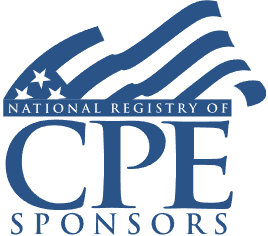Section 754 Elections on Form 1065: Making Valid Elections, Seeking Relief for Missed or Invalid Elections
Mastering the Mechanics of Election Statements, Schedules K-1, Obtaining Relief under Regulation § 301.9100, and More

Course Details
- smart_display Format
On-Demand
- signal_cellular_alt Difficulty Level
Intermediate
- work Practice Area
Tax Preparer
- event Date
Monday, October 2, 2023
- schedule Time
1:00 p.m. ET./10:00 a.m. PT
- timer Program Length
110 minutes
-
BARBRI is a NASBA CPE sponsor and this 110-minute webinar is accredited for 2.0 CPE credits.
-
BARBRI is an IRS-approved continuing education provider offering certified courses for Enrolled Agents (EA) and Tax Return Preparers (RTRP).
This course will provide tax advisers and compliance professionals with a thorough and practical guide to the mechanics of reporting a Section 754 election on a partnership's IRS Form 1065-–“U.S. Return of Partnership Income.” The panel will first discuss the significance, tax stakes, and mechanics of the Section 754 election, and then explain the specific types of relief that may be available when a partnership fails to make a timely and valid election.
Faculty

Ms. Fuller is a corporate and international tax attorney with over 20 years experience in advising a wide range of clients -- including private clients and companies, joint ventures, private equity funds, HNW indviduals, C-Suite executives, "start-ups," and government entities -- on transactional, investment, and supply-chain strategies to achieve optimal tax and business results. She has deep expertise in structuring cross-border M&A transactions, and advising mobile international families. Her clients hail from a multitude of industries, including the burgeoning world of decentralized finance (DeFi). Pamela is also a seasoned taxpayer advocate, with decades of experience resolving complex U.S. federal, state, and foreign tax controversies.

Mr. Dyer manages and reviews all aspects of federal and state tax compliance for C-corporation, S corporation and partnership returns, including consolidated C-corporation returns. He advises businesses on a wide array of tax matters including but not limited to reorganizations and employee benefits. He manages and reviews all aspects of the preparation of high net worth individual returns and conducts tax research on federal and state tax issues. He also handles tax controversies, including at the examination, appeals and collections stages.
Description
The Section 754 election is complex and critical for tax advisers serving partnerships and their partners. Section 754 allows a partnership to make an election to adjust the tax bases of its assets under certain circumstances. In essence, the election provides for a "rebalancing" of the partnership's tax bases in partnership assets under Sections 734 and/or 743 to prevent distortions between the entity’s inside bases in its assets and the partners’ outside bases in their partnership interests. Understanding the Section 754 election is thus an integral and critical part of partnership tax practice.
Missed or incorrect Section 754 elections can easily result in substantial, negative tax consequences to the taxpayers, and thus potential liability claims against tax practitioners and their respective advisory firms. Despite the election’s importance, the calculation and reporting of the requisite tax basis adjustments often challenges and confounds even the most experienced tax practitioners. Tax compliance professionals must not only master the mechanics of calculating and reporting an election on Form 1065, but they must also understand exactly when and how to obtain relief if an attempted election is incorrect or defective, or simply not made on time.
Making the initial election requires that a special statement be filed, that partners be identified, and that specific (and often complex) calculations be done so as to correctly document the tax bases adjustments to be reported on each partner's Schedule K-1. The §734(b) and §743(b) basis adjustments must be correctly allocated pursuant to Section 755.
The Code and Treasury regulations contain both automatic and discretionary relief provisions in the case of missed or defective Section 754 elections. In cases where the taxpayer is seeking relief that is discretionary with the Government, tax advisers must usually show how their client’s situation meets certain requisite criteria and benchmarks in order to qualify their clients for the remedies requested--the elements of which have been delineated in U.S. court cases. There are also specific procedures to correct prior tax basis adjustments, and to request that a prior Section 754 election be revoked or treated as never made.
Listen as our expert panel provides a practical guide to the key tax considerations inherent in determining whether or not a Section 754 election should be made, the mechanics of making a valid Section 754 election, the alternative ways to seek relief for missed or late elections, and the sanctioned methods available for correcting defects in such elections.
Outline
- Substantive overview of the Section 754 election
- Section 743(b): Transfer of partnership interests
- Section 734(b): Distributions of property or cash
- Section 755: Allocation of the §734(b) and §743(b) basis adjustments
- IRS Form 1065: Tips regarding the Section 754 election
- Missed Section 754 elections: Relief available under Reg. § 301.9100
- Automatic extensions of time: Reg. § 301.9100-2
- Non-automatic, discretionary extensions of time: Reg. § 301.9100-3
- Establishing “Reasonable Action and Good Faith” in a PLR request: The positive & negative benchmarks that should be established and discussed
- Specific case studies and examples
- Revoking a Section 754 election
- Final takeaway tips and Q&A
Benefits
The panel will discuss these and other important topics:
- Documentation that must accompany a Section 754 election on a Form 1065 tax return
- Who must sign a Section 754 election?
- A partnership's Section 754 election absent notice from a transferee partner
- Steps for claiming automatic relief under Section 9100
- Seeking Section 9100 discretionary relief – How to draft an effective PLR request and understanding the requisite benchmarks the IRS is likely to consider
NASBA Details
Learning Objectives
After completing this course, you will be able to:
- Determine whether a Section 754 election would be beneficial to a partnership and its partners
- Understand the differences and computational nuances between the tax basis adjustments triggered by an application of Section 734 versus Section 743
- Allocate tax basis adjustments pursuant to Section 755
- Recognize the situations when an adjustment to the partnership’s asset bases is now mandatory
- Fulfill the requirements for making a valid Section 754 election
- Identify and execute the requisite procedures to remedy a late or defective 754 election
- Ascertain the reasons, and the requisite procedures, for successfully revoking a 754 election
- Field of Study: Taxes
- Level of Knowledge: Intermediate
- Advance Preparation: None
- Teaching Method: Seminar/Lecture
- Delivery Method: Group-Internet (via computer)
- Attendance Monitoring Method: Attendance is monitored electronically via a participant's PIN and through a series of attendance verification prompts displayed throughout the program
- Prerequisite: Three years+ business or public firm experience at mid-level within the organization, preparing partnership and partners tax forms. Specific knowledge and understanding of partnership taxation, partner capital accounts, section 734 and 743 basis adjustments, the tax consequences resulting from partnership distributions and the sale of partnership assets; familiarity with the rules governing IRC 754 calculations, section 754 elections and section 755 allocations.

Strafford Publications, Inc. is registered with the National Association of State Boards of Accountancy (NASBA) as a sponsor of continuing professional education on the National Registry of CPE Sponsors. State boards of Accountancy have final authority on the acceptance of individual courses for CPE Credits. Complaints regarding registered sponsons may be submitted to NASBA through its website: www.nasbaregistry.org.

Strafford is an IRS-approved continuing education provider offering certified courses for Enrolled Agents (EA) and Tax Return Preparers (RTRP).
Related Courses

Medicaid Asset Protection Trusts: Technical Overview and Tax Considerations
Available On-Demand

Family Partnerships: Navigating the Discounting Rules for Family-Controlled Entities
Thursday, March 6, 2025
1:00 p.m. ET./10:00 a.m. PT

Form 1041 Schedule D: Reporting Capital Gains for Trusts and Estates
Available On-Demand
Recommended Resources
How CPE Can Bridge the Gap Between What You Know and What You Need to Know
- Career Advancement